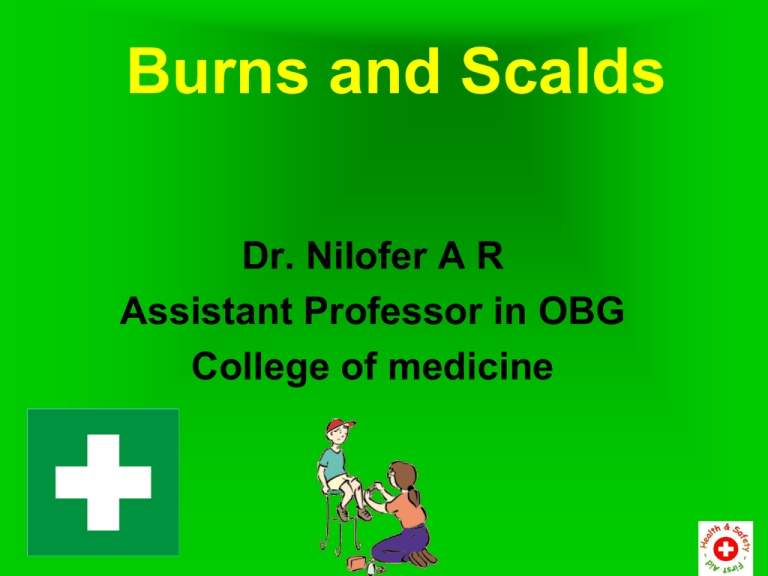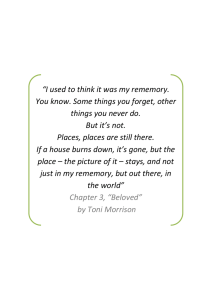Burns and Scalds Dr. Nilofer A R Assistant Professor in OBG
advertisement

Burns and Scalds Dr. Nilofer A R Assistant Professor in OBG College of medicine Burns and Scalds The First Aider should: • Establish your own safety • Stop the burning by rapid cooling • Cover the injury • Obtain appropriate medical treatment Pages 60-61 Burns and Scalds • The First Aider SHOULD NOT: • • • • Touch the burnt area Break blisters or remove loose skin Use adhesive, dry or fluffy dressings Apply anything (lotions, ointments etc) to the burnt area • Apply water under pressure Pages 60-61 Burns and Scalds • Types / Causes of burns » Dry Burns » Wet Burns » Cold Burns » Friction Burns » Radiation Burns » Electrical Burns » Chemical Burns Pages 60-61 Assessing Burns Pages 60-61 Assessing Burns Pages 60-61 Assessing Burns Pages 60-61 Severe Burns and Scalds Aims • • • • • Halt the burning process Resuscitate if necessary Treat associated injuries Minimise risk of infection Arrange urgent removal to hospital Pages 60-61 Severe Burns and Scalds Treatment • Lay casualty down – protecting burned area • Douse burn with copious amounts of cold water (thorough cooling may take 10 minutes) • While cooling, check airway, breathing, pulse • Carefully remove rings watches etc • Carefully remove burned clothing unless it is sticking to the wound Pages 60-61 Cooled clothing removed, and cool again Burns and Scalds Dressings • Cover the burn with clean, non-fluffy material to protect it from infection. The dressing does not need to be secured. Alternate Dressing • To dress a burned hand or foot – you can use a plastic bag or kitchen fil. Secure the bag with a bandage or plaster around the bag, not the skin. Pages 60-61 Burns to Mouth and Throat • Burns in this area are very serious as they can cause swelling and inflammation of the air passage. If necessary loosen clothing from around the neck Call for an ambulance immediately Pages 60-61 Electrical Burn • An electric shock from a low voltage source can result in burns. • These may occur at both the point of entry and exit of the electric current. Page 59 "More than 3,000 people a year experience electric shocks in their home.* Electrocution can cause heart failure and is potentially lethal." * DTI figures for 1999. Page 59 Electrical Burns Treatment • Treat as per other burns. • Position and direction of entry and exit wounds will alert you to the likely extent of hidden injury, and to the degree of shock that may ensue. Call for an ambulance Do NOT touch the casualty directly until you are sure the current is switched off. Pages 59, 60-61 Chemical Burn to Skin • Chemical burns may be caused by household agents such as oven cleaner or paint stripper. • The burns are serious but signs develop more slowly than for thermal burns. Chemical Burn to Skin Recognising chemical burns • Fierce stinging pain • Redness or staining, followed by • Blistering and peeling Chemical Burn to Skin Treatment • Wash all traces of the chemical but holding the affected area under plenty of running water. • Gently remove any contaminated clothing while flooding the injury • Loosely cover the burn with clean, non-fluffy material. You can wet the covering material to aid cooling. Chemical Burns REMEMBER! • Note the name of the substance that caused the burn • Wear protective rubber gloves • Beware of fumes • Irrigate for longer than you would for thermal burns Chemical Burn to the Eye • Splashes of chemical can cause serious injury if not treated quickly • They can damage the surface of the eye causing scarring or blindness Aims • To disperse the harmful chemical • To arrange removal to hospital "There are more than 120,000 accidents involving eye injuries every year.* Many of us have experienced having something in our eye, but the trick is knowing which injuries you can treat at home and which should be left to the professionals." *DTI figures for 1999. Chemical Burn to the Eye Treatment • Hold the casualty’s head over a basin with the “good” eye uppermost. • Gently irrigate the contaminated eye for at least 10 minutes. • Ensure both sides of eyelid are thoroughly washed and that water drains away from the face. Chemical Burn to the Eye Treatment cont’d • You may find it easier to use a jug to pour water over the affected area. • Avoid splashing the “good eye with contaminated water Chemical Burn to the Eye Treatment cont’d • When the injured eye is thoroughly washed, cover it with a sterile dressing. Hold the dressing in place until you get medical aid. • Take the casualty to hospital, OR • Call an ambulance Chemical Burn to the Eye REMEMBER ! • DO NOT let the casualty touch his eye. • The eye will be shut in spasm and pain, so gently pull the eyelids open. Thank you End of Section




